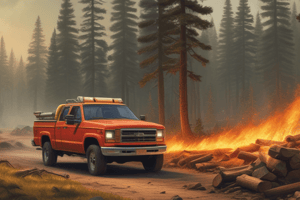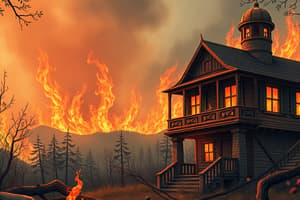Podcast
Questions and Answers
What is the purpose of the SOG mentioned in the text?
What is the purpose of the SOG mentioned in the text?
- To outline procedures for medical emergencies
- To establish communication protocols during fire emergencies
- To ensure safety of emergency personnel and uniform response in wild land fire fighting (correct)
- To provide guidelines for urban fire fighting
What does the scope of the SOG cover?
What does the scope of the SOG cover?
- All medical emergency situations
- All personnel conducting wild land fire fighting operations and training (correct)
- Only personnel using SCBA masks
- Only the Incident Commander and Operations Chief
What is the minimum PPE requirement mentioned in the text?
What is the minimum PPE requirement mentioned in the text?
- Fire-resistant boots
- SCBA masks
- Protective face shields and particulate filters
- Full wild land gear (correct)
When should SCBA masks be worn according to the text?
When should SCBA masks be worn according to the text?
What should be done upon arrival at a staging area?
What should be done upon arrival at a staging area?
When should fire shelters be deployed?
When should fire shelters be deployed?
What should the Incident Commander do when planning ahead for the next operational level?
What should the Incident Commander do when planning ahead for the next operational level?
What should be done upon release from the incident?
What should be done upon release from the incident?
When should safety protocols be followed?
When should safety protocols be followed?
What should the Incident Commander do if additional resources are needed?
What should the Incident Commander do if additional resources are needed?
What should be used for radio communications for unit responses greater than 2?
What should be used for radio communications for unit responses greater than 2?
What should be completed for all mutual aid, Strike Team, and Task Force responses?
What should be completed for all mutual aid, Strike Team, and Task Force responses?
Where should fire attack typically start?
Where should fire attack typically start?
What should be done when using the brush truck?
What should be done when using the brush truck?
What should Level III response protocols include?
What should Level III response protocols include?
When should the IC conduct PAR's?
When should the IC conduct PAR's?
Flashcards are hidden until you start studying
Study Notes
Wildfire Response Protocol
- Upon arrival at a staging area, follow the Accountability/Passport Protocol.
- Complete and turn in the "Mutual Aid Accountability Form" for all mutual aid, Strike Team, and Task Force responses.
- Establish command based on the department's IMS protocol.
- Use assigned tactical channels for radio communications for unit responses greater than 2, and use the Lee County Fire Chiefs' Association Mutual Aid Channels matrix for responses of more than 5 units, Strike Team(s), Task Force(s), etc.
- Incident Commander should request additional resources as needed, including brush trucks, engines, tenders, Strike Team(s), Task Force(s), and Florida Forestry Service (FFS).
- Fire attack should typically start at the rear/heal of the fire and move forward along the flanks towards the head, but exceptions may be necessary.
- Upon release from the incident, collect passport and vehicle identifier, check equipment, report missing equipment and damages, and complete required forms.
- Safety protocols include staging apparatus in the warm and hot zone on burned vegetation, not using the brush truck as a bulldozer, maintaining distance from operating dozers and air tankers/helo buckets, leaving a quarter tank of water in the brush truck when exiting the hot zone, and staying hydrated.
- Fire shelters should be deployed when the possibility of being burned over is apparent, and caution should be exercised while driving brush trucks, especially in residential areas.
- The IC should plan ahead for the next operational level, with specific responsibilities and actions outlined for Level I, Level II, and Level III wildfire response scenarios.
- Level II and Level III response protocols include establishing formal Command Post, geographic divisions, communication plan, accountability, rehab area, rapid intervention crew/company, conducting PAR's every 30 minutes, and planning for the next operational period.
- Level III response includes additional steps such as requesting an FFS Supervisor, Strike/Task Force Team(s), Incident Management Team, Area Command, PIO, air support, and establishing a Demobilization Plan.
Studying That Suits You
Use AI to generate personalized quizzes and flashcards to suit your learning preferences.



